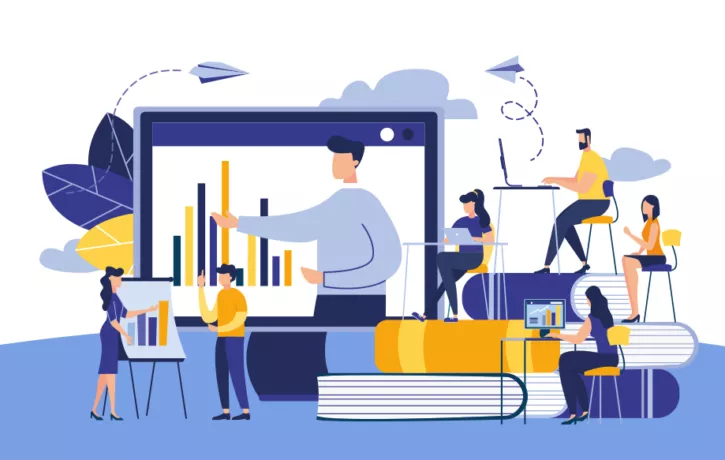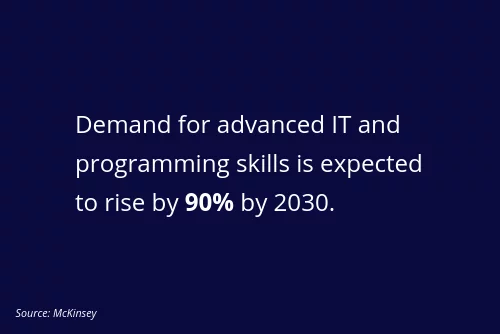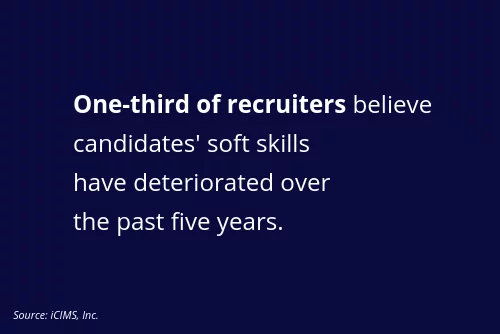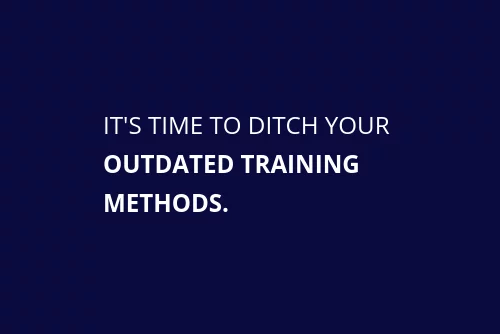Digital technology is emerging in all facets of business — and the transition isn’t happening slowly. As the very nature of work evolves, so must our methods of training for it.
The digital age demands an updated employee training definition.
Digital tools demand digital skills
Software and tools are constantly evolving, which has a massive impact on the way we evaluate, hire, and train.
Today, demand for certain types of employee skills, capabilities, and experience is completely different than in the past.
Digital literacy is more important than ever. The need for advanced IT and programming skills is expected to increase by 90% by 2030, according to research from McKinsey. But even basic digital skills will be in need — they will be in demand 69% more.
Even in the age of all things digital, soft skills – such as adaptability, communication, collaboration, creativity, and problem-solving – are still critical, perhaps even more than before.
Dive Deeper: The Employee Training Manifesto for Enhanced Productivity
What does the research say?
Technology changes daily, which makes it difficult to keep training programs relevant.
According to research conducted by MIT Sloan Management Review and Deloitte:
- 90% of employees realize they need to update their skills annually
- 44% feel they need to continually update their digital skills to stay relevant
- Only 34% feel satisfied with their training programs
- Survey respondents felt on-the-job learning was the most useful type of training
These findings shouldn’t come as a surprise. Employees want effective training that lets them develop useful skills so they can succeed in their jobs. The real question for training managers is: How do you create a new training definition to encompass all of the employees’ needs?
Reimagining your training definition
The solution is changing the way we think about training.
A business has one set of needs, and employees have another. Effective training will address both. For many companies, that requires a new definition of training altogether.
So, how should you evolve your employee training for the digital age?
Here are a few core ideas to help you redefine your approach to training:
Effective digital training is a must
Today, digital skills are the cornerstone of success.
Therefore, digital training should be central to the current training definition. Providing digital training helps employees stay relevant from a talent perpsective, increase productivity, and improve performance.
Not only does it help them succeed in their current role, but it will also help them achieve their long-term career goals.
Soft skills are more important than ever
Technical skills are clearly useful, but so are soft skills.
Research by iCIMS, Inc., showed that when evaluating new candidates, employers look for soft skills such as:
- Problem-solving
- Adaptability
- Time management
- Professionalism
- Enthusiasm
The 2017 report also revealed that one-third of recruiting professionals feel that job candidates’ soft skills have deteriorated over the past five years.
In short, as iCIMS chief economist, Josh Wright, put it, “the human element is key to many of today’s fastest-growing jobs.”
An updated definition of employee training
It’s clear both technical and soft skills need to be included, but you might be wondering what exactly the updated training definition should be. Here’s our take on it:
Effective employee training in the digital age is a formal system for teaching employees the necessary skills and processes for completing their responsibilities. It includes adequate resources and systems to enable employees to use digital tools effectively and to their highest capabilities; it emphasizes long-term growth and personalized development opportunities to meet individual employee needs and goals.
Discover why training managers love the Digital Adoption Platform (DAP). Request a demo.
5 Practical Tips for Upgrading Your Training Program
Now you know how to think about employee training in the digital workplace. But how do you make the necessary improvements to it?
Here are a few tips to help you upgrade your training solutions.
1. Use digital adoption platforms
Digital adoption platforms (DAPs) let employees pick up digital skills as they go.
These automated platforms use in-app training to cut down on costs, training time, and employee frustration.
DAPs are less costly and more effective than traditional training solutions. They’re easy to use and more advanced than other training solutions — powered by AI, data analytics, chatbots, and other advanced tools to provide personalized, context-sensitive guidance at the moment of need.
2. Empower digital leaders
In an increasingly digital work environment, many organizations are realizing the need to hire a leader dedicated to promoting digital adoption.
While not every company has the resources to appoint a digital adoption manager, it is possible to appoint informal leaders or “champions” to help drive digital adoption forward.
Within each department, leaders must take responsibility to provide adequate resources and training to employees so they can use all of their digital tools effectively.
3. Place more emphasis on experiential learning
Classroom learning is too “old school” and ineffective in today’s fast-paced workplace.
People forget much of what they’ve learned, or the information turns out to be irrelevant.
With the advent of digital media, there are other options available, such as:
- Digital Adoption Platforms (DAP)
- Guided in-app training
- Knowledge bases
- Gamification
Part of adapting to digital technology means using digital media to teach.
4. Adjust your measures of performance
Performance measurement should evolve along with the rest of the training program.
In an era where adaptation drives success, it’s important to reward experimentation, creativity, and innovation.
Use qualitative and quantitative metrics, measure users’ understanding of the training goals, and create metrics specifically for digital training.
5. Deliver training in multiple formats
Everyone learns differently. Different training formats will be more or less productive depending on the person’s learning style.
Some prefer text, so text-based learning materials will produce better results for them. Others prefer video, audio, or hands-on training.
The more formats you can provide for your learners, the more effective your training will be.
Evolve to succeed
To keep up with changing work environments and new employee demands, training must also evolve.
If training managers and HR professionals can adapt, then they will help employees succeed, deliver better training programs, and add more value to their organizations.




